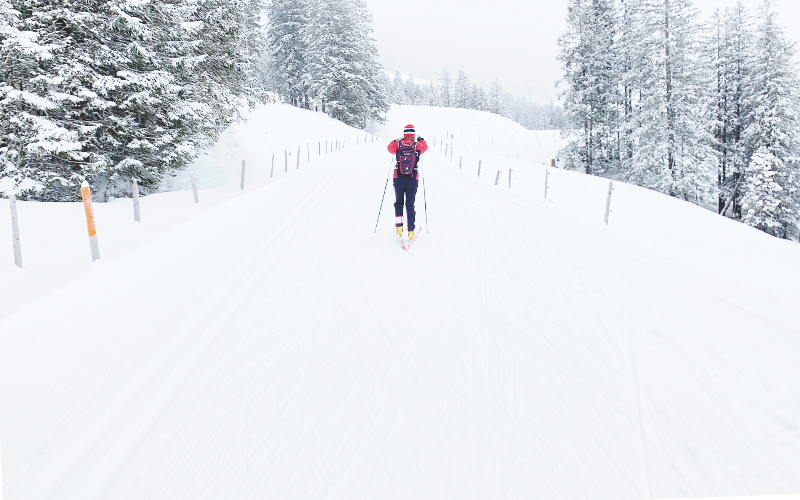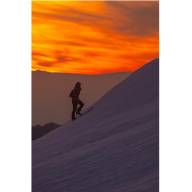Any idiot can do it. If you can slide one foot in front of the other, you can be a cross-country skier. If you can walk (or if you can run), you can cross-country ski. Nothing to it.
That's a prevailing attitude among people who have never (or only occasionally) tried the sport, especially haughty downhill skiers who think of their sport as daringly athletic and cross-country as the choice of lily-livered klutzes, unable to master the skill and chutzpah it takes to link smooth, downhill turns. Downhill skiers are real skiers; cross-country skiers are plodders.
This is one of the main reasons why most people, when they give cross-country a try, don't bother to take a lesson. They watch skate skiers whizzing around the trail network and acknowledge that skating might entail some technical mastery and athletic skill. But traditional cross-country skiing -- the classic technique? Just lace up your klutz boots and plod away.
This attitude is both right and wrong. It's right in that almost any klutz can do it at a rudimentary level. Many inexperienced skiers come to Ole's or Blueberry Lake and are perfectly content to shuffle around, enjoying the fresh air and the wintry views. They put one foot gently in front of the other at a dreamily languid pace, and there is nothing wrong with that. They're outside getting some exercise, and that's a whole lot more interesting and satisfying than a day of epic couch surfing. But there is a whole world of cross-country skiing beyond that, technically speaking, and those who choose to take a lesson often find entry into that world eye-opening. They discover a previously unimagined way of skiing that is both athletically demanding and psychically rewarding.
The physical skills required in both classic and skate skiing -- balance, timing, power, flexibility, efficiency, and even guts -- can, in many ways, surpass those of downhill skiing. After all, downhillers can move with incredible inefficiency and awkwardness -- klutziness -- and still get to where they're going thanks to the ineluctability of gravity's pull. A cross-country skier, on the other hand, usually can't count on gravity for forward propulsion. Without technical proficiency, the cross-country skier putters along at best or, worse, ends up dead in the water, like a becalmed ship.
Because skate skiing is faster and involves movements that are at least perceived to be more explosive and dynamic, it is often thought to be technically more complex and demanding. However, the three-part fundamentals of classic striding and skating are actually the same -- push-off, weight transfer, and glide. The fundamentals are simply applied differently. With a skating stride, push-off happens with an angled edge in the snow; with a classic stride, push-off happens when a ski's "kick zone" -- the textured, "waxless" surface, sticky kick wax, or synthetic-mohair skin underfoot -- is pushed straight down into the snow.
In subtle ways -- in the precise timing of the kick, the exact direction and crispness of the weight transfer, the sustained, one-legged balance for gliding -- classic skiing can often be more challenging to pick up than skate skiing. A slight misfire in the push-off timing or a slight miscalibration in the one-legged balance, for example, can result in diminished glide with each stride. Multiply that little bit of lost glide per stride by the hundreds or thousands of strides needed in, say, a 20-kilometer ski, and the value of technical precision really adds up. At the elite level of the sport (World Cup and Olympic racing), U.S. skiers have achieved much greater success in skate races than classic races, and a reason often given is that Scandinavian skiers, having grown up classic skiing, have developed an almost intuitive feel for the subtleties of the classic technique.
What people learn in taking a lesson is that gliding on snow, not walking or shuffling, is the real name of the game. Learning how to generate a longer, sustained glide with each stride, whether classic skiing or skating, is the reward of applying the technical fundamentals correctly. Speed and efficiency increase, and with that the true pleasures of the sport begin to blossom.
The good news is that snooty attitudes toward cross-country instruction are showing signs of subsiding. The report from Ole's this winter is that a whole lot of skiers have been seeing the light and are taking lessons. That was true last winter, too, but even truer this winter, and it's a trend happening nationwide. According to Reese Brown, executive director of the Cross Country Ski Areas Association, "Similar (reports) are coming from ski areas all across North America. It's in part due to all the new cross-country skiers coming into our sport."
The new influx was initially spurred by a nationwide desire to escape pandemic lockdowns by getting outside and playing, but post-pandemic momentum continues. And whatever the reason might be, skiers, in increasing numbers, apparently not only want to learn how to do cross-country the right way, they want to learn how to do it right, right from the start. Only an idiot would fail to see the good sense in that.













